Books
Books

Rainbow Woman
In her work, Dutch artist Femmy Otten (°1981) explores a very hybrid world of inspiration, ranging from sculptures from Greek antiquity and Italian painters of the quattrocento to American outsider art and contemporary art. She brings all these influences together in a precise yet unfathomable iconography.
The book Rainbow Woman shows mainly recent work, but also revisits a number of older works which Otten has regularly placed in a new context throughout her artistic practice and which have now also been given a new shape in the context of the exhibition in the Warande, Turnhout (01.08-07.11.2021).
Rainbow Woman shows Otten as a versatile painter, sculptor, draughtsman and performer. In ‘Donna Universale’, the art historian Leen Huet places Otten in a tradition of self-confident, female artists that Europe has known since the early Renaissance but who have only sporadically entered the history books as artistically accomplished artists.
The book has many points of contact with the exhibition Rainbow Woman but can also be seen as a sequel to the artist’s book Slow Down Love (2016, nai).

Horaizon
Meggy Rustamova’s (b. 1985) practice explores films and spatial installations, in which she incorporates photographs, essays and audio material; often the work has a performative character. Concerned with the relations between individual and collective memory, language and human behaviour, her works look for ways to translate the current matters and phenomena in the world.
The title of the book and the exhibition, HORAIZON, refers to the phonetic pronunciation of the English word ‘horizon’, the boundary line on which the earth’s surface and the sky seem to touch. The horizon, interpreted as ‘boundary’ or ‘line’, is equally perceptible in language, when reading between the lines, or when travelling between international borders. The contours of the land, trees or buildings, which contrast with the sky, but also the contours of shadows can be observed in many of the images in the exhibition. The works also suggest a longing for what lies behind the horizon and invite the viewer to make an imaginary journey.
On the occasion of Rustamova’s exhibition at the Vrienden v/h S.M.A.K. and the book ‘Horaizon’, the artist created a multiple. The multiple is entitled 1000 km in Vogelvlucht — 621.371 miles at Bird’s Eye View and unfolds as a storyboard, with a collection of sky views and birds the artist has captured over the past two years. From a condor in Arizona to the black-backed gulls in Iceland in the North Atlantic Ocean all through the Sea of Marmara, the book seeks to create a tale that reflects on a person’s daily need for freedom, travel and nature.

Morning Change
Morning Change is a book on movement, location and nomadism in the oeuvre of the Brussels based German artist Heide Hinrichs (b. 1976). It is an invitation to follow different lines that are directed east — east of Kassel, east of Busan, east of Seattle, east of London. The lines are drawn over continents and oceans, against the Earth’s own movement we unconsciously witness with each sunrise. Within the traces of these lines, static objects are put back into motion and they are made to leave their recommended positions of meaning.
The publication brings together three groups of works, developed over different periods of time between 1999 and 2018, exploring the artist’s recurring interest in these topics.
the horse — a story that starts 10 year after the fall of the Iron Curtain, Silent Sisters / Stille Schwestern together with a series of drawings and installations that were conceived in response to DICTEE — a text written by the Korean-American artist Theresa Hak Kyung Cha and On Some of the Birds of Nepal (Parting the Animal Kingdom of the East) — an installation that Hinrichs created in the context of the first Kathmandu Triennale 2017.
An essay by Elizabeth Haines is woven through Morning Change.

Hundred Zundert
Nel Aerts (b. 1987) moves in a freely, intuitive way between different media as painting, drawing, collage, performance and sculpture. Since a few years she focuses more often on the portrait-genre, which she visualises on paper or on wooden panels, with careful attention to the different qualities of each material. As such, she is creating a large collection (family almost) of posing subjects caught between abstract patterns and hard-edged figuration. The figures she portraits refer to both popular culture and her direct, everyday surroundings.
The self-portraits are tragicomic in the sense of the contrasts they evoke. Alternately they are desperate or funny, extra- or introverted, thought- or playful carved from wood or originated as a collage, but they are always introspective and self-relativistic.
In Hundred Zundert, “Nel Aerts evokes a visual rendezvous with Vincent van Gogh and sets the tone for the near one hundred drawings that would be made during her three-month residency at the Van Gogh House in Zundert. Rather than ‘following in the footsteps of Van Gogh’, Aerts is interested in examining the mud and earth around them by (literally) placing herself in the environment of Van Gogh’s youth. The resulting work is characterised by a deceptive interplay between formal simplicity and playfulness which belies a substantial complexity. (…) Nel Aerts’s working process is uncomplicated and free of any pretension: black ball pen (dozens), sheets of white A4 paper (hundreds) and spontaneous, almost naive line work (in seemingly infinite supply) are the building blocks of a story that is nevertheless rich in visual and intimate detail, a story that teeters between seriousness and playfulness, at once both comical and deeply emotive.” From: ‘Portrait of the Artist’, Grete Simkuté, in: Hundred Zundert.

Time and Tide
“In selecting the photographs for this publication, Lisa Spilliaert (b. 1990) was adamant that the image of a sunrise should be among the first in her book. It is, indeed, an emblematic image. For anyone with a camera, such a splendid sunrise is an irresistible trope: a visual motif that simply begs to be captured and fixed on film. In reality, however, the magic of this scene resides in the fleeting, subtle changes in colours and vibrations. This is the dynamic that captivates us.
Photography is usually understood as a technique for ‘stopping’ the flow of time. But as Spilliaert here demonstrates, the impact of photography can also be used to manifest an awareness of time and transience. By accentuating the photographer’s fixed position vis-à-vis the endlessly changing light source, Spilliaert evokes a correlation between stasis and movement, between the cosmic and the mundane. This duality is echoed again in the confrontation of the two equivalent silhouettes: that of the photographer and of his alias or ‘partner’: a life-size technical camera.” — From ‘Time and Tide’ Edwin Carels

Stili Drama XIII-XXI / La Giostra di Lulu XLI-XLIV
The materials collected in the publication have been developed departing from the documentation, transcription and translation of textual, visual, sculptural and audio materials produced between March and November 2021 for STILI DRAMA.
STILI DRAMA is an open-ended episodic para-cinematographic project, which functions as a spontaneous expression of MRZB research. STILI DRAMA XVIII-XXI and LA GIOSTRA DI LULU XLI-XLIV are the two first fragments of the work.
Language: English, Italian
Edition of 100 copies

Hatred of Sex
Hatred of Sex links Jacques Rancière's political philosophy of the constitutive disorder of democracy with Jean Laplanche's identification of a fundamental perturbation at the heart of human sexuality. Sex is hated as well as desired, Oliver Davis and Tim Dean contend, because sexual intensity impedes coherent selfhood and undermines identity, rendering us all a little more deplorable than we might wish. Davis and Dean explore the consequences of this conflicted dynamic across a range of fields and institutions, including queer studies, attachment theory, the #MeToo movement, and "traumatology," demonstrating how hatred of sex has been optimized and exploited by neoliberalism.
Advancing strong claims about sex, pleasure, power, intersectionality, therapy, and governance, Davis and Dean shed new light on enduring questions of equality at a historical moment when democracy appears ever more precarious.

Words For War
The armed conflict in the east of Ukraine brought about an emergence of a distinctive trend in contemporary Ukrainian poetry: the poetry of war. Directly and indirectly, the poems collected in this volume engage with the events and experiences of war, reflecting on the themes of alienation, loss, dislocation, and disability; as well as justice, heroism, courage, resilience, generosity, and forgiveness. In addressing these themes, the poems also raise questions about art, politics, citizenship, and moral responsibility.
The anthology brings together some of the most compelling poetic voices from different regions of Ukraine. Young and old, female and male, somber and ironic, tragic and playful, filled with extraordinary terror and ordinary human delights, the voices recreate the human sounds of war in its tragic complexity.

Five Essays from Present Continuous
The five essays printed here are excerpted from Part I of Present Continuous, a book of prose written during the first year of the coronavirus pandemic between March 2020 and April 2021 in Lewisham, London.
The essays in the present volume were written between March 2020 and June 2020: the movement from spring to summer, from the first announcement of a national lockdown to the Black Lives Matter protests sparked by the murder of George Floyd and Breonna Taylor in the United States and the death of Belly Mujinga in the UK. Nearly two years on, following a seemingly endless series of virus variants and subvariants, an apparent shift from pandemic to endemic, and a kind of exhaustion of vocabulary and will, I hope they provide some sort of record, not just of where “we” were in 2020, but where “we” are – or might be – now. (David Grundy, London, January 2022)
“It’s 2018 and we’re still on a train out of London, it’s 1967 or 1970 and Coltrane and Ayler are still in their material form, it’s 1943 and Artaud’s letters spill their remainder on the page, it’s April 2020 and all those presences are gone but their traces remain in the split voice, the overtone, the greater frequency overwhelming that base note which no longer guides in circumscribed lines. The actual presence of actual ghosts, silver on the mirrors, lost poetry, the noise it makes. It’s from the condition of being in the abyss itself that we learn how to climb out of it.”

Acoustic Thought
Acoustic Thought is an exegesis of the Gospel of Thomas, an apocryphal gospel found at Nag Hammadi in Upper Egypt in 1945.
With a score for six female voices by Lisa Holmqvist; a collage of writings by medieval female mystics; and photographs taken by Jeff Weber at the Coptic Museum in Cairo, during a research period at Beirut project space.
The book’s covers reconstruct patterns found on the covers of Nag Hammadi Codex II, which, as well as the Gospel of Thomas, contains the Apocryphon of John, the Gospel of Philip, the Hypostasis of the Archons, On the Origin of the World, the Exegesis on the Soul, and the Book of Thomas the Contender.
Presented and performed during Perfomance Days, Amsterdam (November 2014) and Hotel Theory, REDCAT, Los Angeles (November 2015).
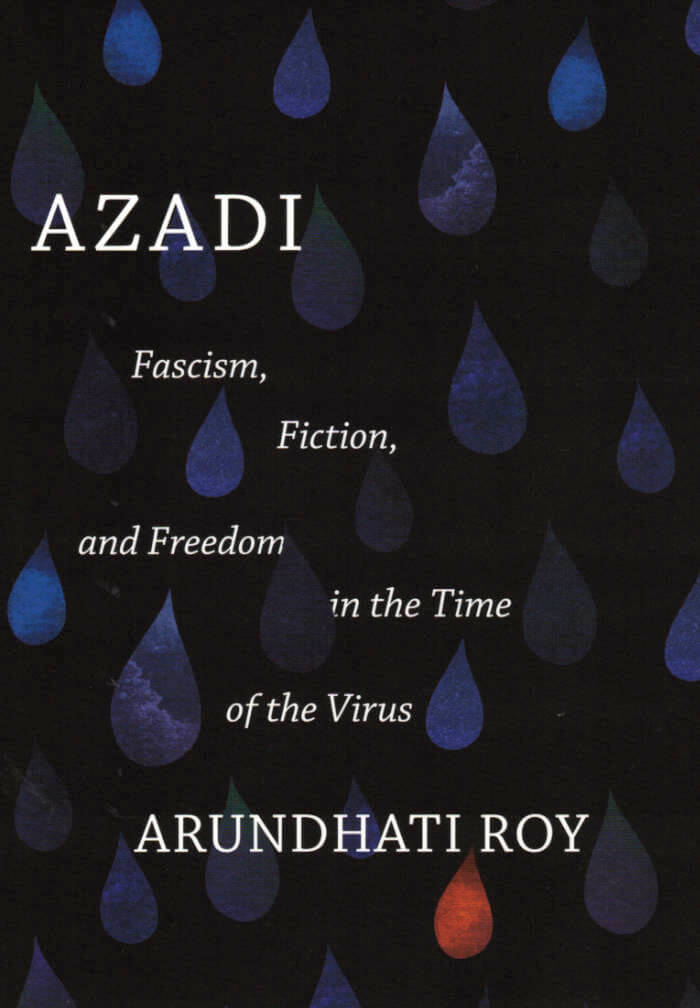
Azadi: Freedom. Fascism. Fiction.
The chant of 'Azadi!' — Urdu for 'Freedom!' — is the slogan of the freedom struggle in Kashmir against what Kashmiris see as the Indian Occupation. Ironically, it has also become the chant of millions on the streets of India against the project of Hindu nationalism. Just as Arundhati Roy began to ask what lay between these two calls for freedom — a chasm or a bridge? — the streets fell silent. Not only in India but all over the world.
The coronavirus brought with it another, more terrible understanding of azadi, making nonsense of international borders, incarcerating whole populations, and bringing the modern world to a halt like nothing else ever could.
In a series of essays, Arundhati Roy challenges us to reflect on the meaning of freedom in a world of growing authoritarianism
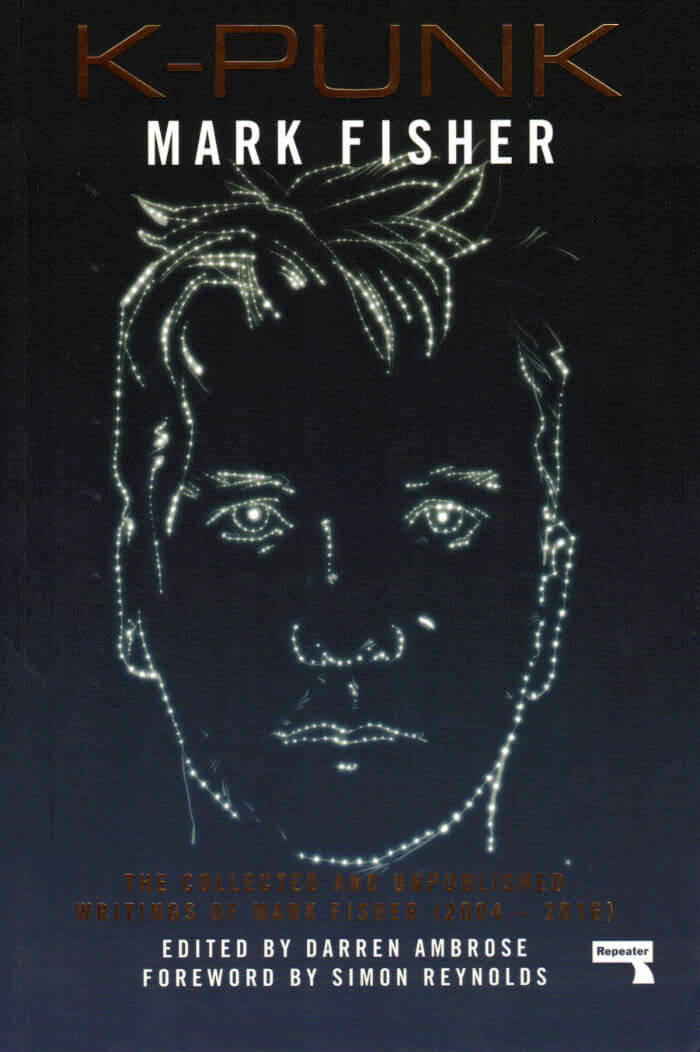
K-Punk: The Collected and Unpublished Writings of Mark Fisher
A comprehensive collection of the writings of Mark Fisher (1968-2017), whose work defined critical writing for a generation.
This collection brings together the work of acclaimed blogger, writer, political activist and lecturer Mark Fisher (aka k-punk). Covering the period 2004 - 2016, the collection will include some of the best writings from his seminal blog k-punk; a selection of his brilliantly insightful film, television and music reviews; his key writings on politics, activism, precarity, hauntology, mental health and popular modernism for numerous websites and magazines; his final unfinished introduction to his planned work on Acid Communism; and a number of important interviews from the last decade.
Edited by Darren Ambrose and with a foreword by Simon Reynolds.
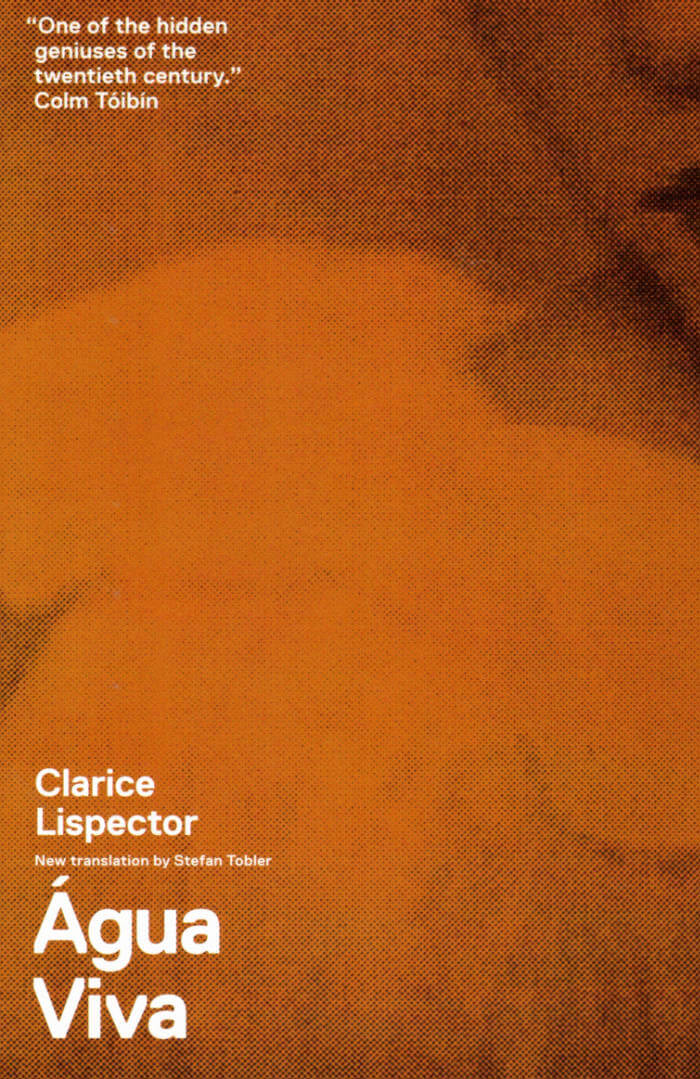
Água Viva
In Água Viva Clarice Lispector aims to 'capture the present'. Her direct, confessional and unfiltered meditations on everything from life and time to perfume and sleep are strange and hypnotic in their emotional power and have been a huge influence on many artists and writers, including one Brazilian musician who read it one hundred and eleven times. Despite its apparent spontaneity, this is a masterly work of art, which rearranges language and plays in the gaps between reality and fiction.
Clarice Lispector (December 10, 1920 – December 9, 1977) was a Brazilian writer acclaimed internationally for her innovative novels and short stories. Born to a Jewish family in Podolia in Western Ukraine, as an infant she moved to Brazil with her family, amidst the disasters engulfing her native land following the First World War.

Brown Rice
Don Cherry's ecstatic world fusion masterpiece of the '70s, wedding Indian, African, and Arabic music to Miles Davis' electrified jazz-rock innovations.
Brown Rice is probably the most accessible entry point into Cherry's borderless ideal, jelling into a personal, unique, and seamless vision that's at once primitive and futuristic in the best possible way. Its title track is a sensual fusion of various styles and sounds from the African, Indian and Arabic traditions. It also represents the spiritual multiculturalism that Cherry was interested in exploring during this creative period. With ex-Ornette Coleman cohorts on board—Billy Higgings on drums and Charlie Haden on double bass (also heard on electric)—the album (originally released in Italy in 1975) is a cult on its own.
Don Cherry (1936-1995), composer-trumpet player, flutist, percussionist and pianist, is an essential figure in American jazz, free jazz and avant-garde music.
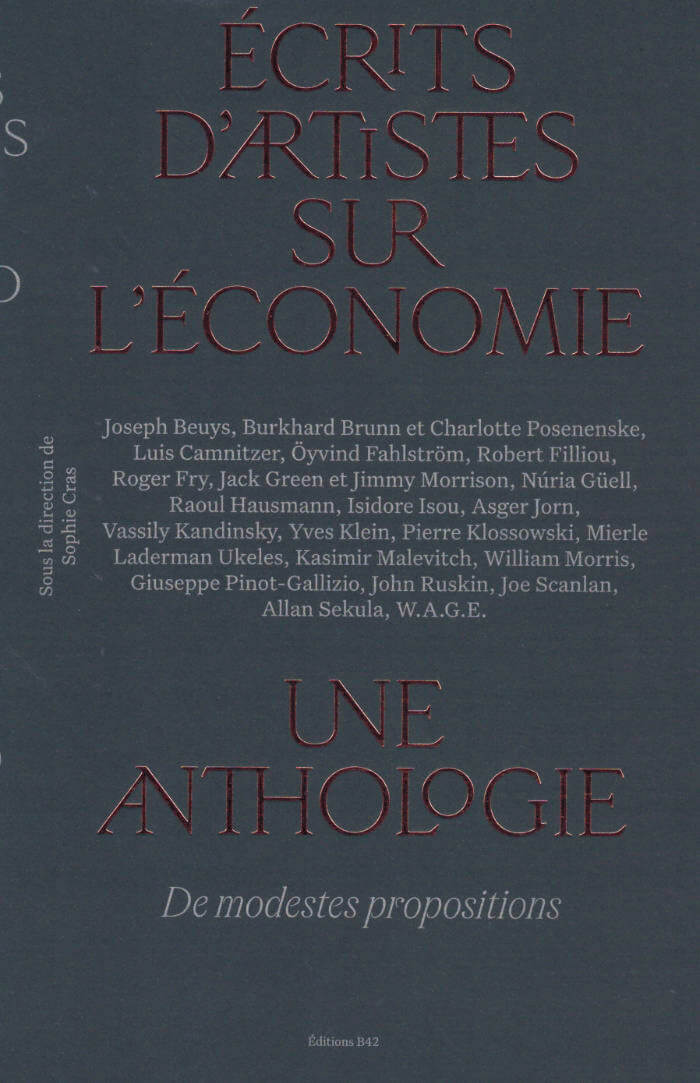
Écrits d'Artistes Sur L'Économie
Qu’advient-il de l’économie lorsqu’elle est pensée, inventée et rêvée par les artistes ? On le sait peu, mais nombreux furent celles et ceux qui, de la fin du XIXe siècle jusqu’à aujourd’hui, se firent un temps économistes, allant jusqu’à rédiger de véritables traités dont l’ambition affichée était de renouveler la discipline de fond en comble.
Qu’ils aient suivi une formation universitaire en économie, construit leur conception théorique de l’art en dialogue avec des économistes, ou élaboré un système théorique à part entière, ces artistes nous livrent une vision riche et singulière, tant sur la pensée économique de leur temps que sur les enjeux actuels. Valeur, travail, monnaie et capitalisme – autant de thèmes scrutés et revisités par ces textes, dont le présent ouvrage se propose de faire l’anthologie.
Avec: Joseph Beuys, Burkhard Brunn, Luis Camnitzer, Sophie Cras, Öyvind Fahlström, Robert Filliou, Roger Fry, Jack Green, Núria Güell, Raoul Hausmann, Isidore Isou, Asger Jorn, Vassily Kandinsky, Yves Klein, Pierre Klossowski, Mierle Laderman Ukeles, Kasimir Malevitch, William Morris, Jimmy Morrison, Giuseppe Pinot-Gallizio, Charlotte Posenenske, John Ruskin, Joe Scanlan, Allan Sekula, W.A.G.E. (Working Artists and the Greater Economy).

Visualisation. L'interprétation modélisante
Les diagrammes, cartes et visualisations de données ont conquis le domaine de la recherche en arts, lettres et sciences humaines. Pour certains chercheurs, ces formes graphiques consistent à exploiter des données quantitatives jusqu’ici délaissées, pour d’autres, elles offrent la possibilité d’explorer les relations discrètes qu’entretiennent des corpus hétérogènes. Mais sur quels fondements épistémologiques reposent ces opérations techniques et intellectuelles ? Dans le cadre de la production du savoir et de son interprétation en régime numérique, est-il possible de dépasser le simple effet d’affichage des données, certes bluffant au premier abord, et d’envisager autrement les interfaces et les logiciels ?
Considérée aujourd’hui comme l’une des plus importantes théoriciennes des humanités numériques, Johanna Drucker livre dans cet ouvrage, spécialement rédigé pour la collection, une alternative aux formes dominantes de la visualisation de l’information. Héritière de la tradition humaniste, elle propose une approche qui réhabilite l’idée d’un sujet situé et incarné qui expérimente et conceptualise les connaissances par le prisme de la représentation graphique.
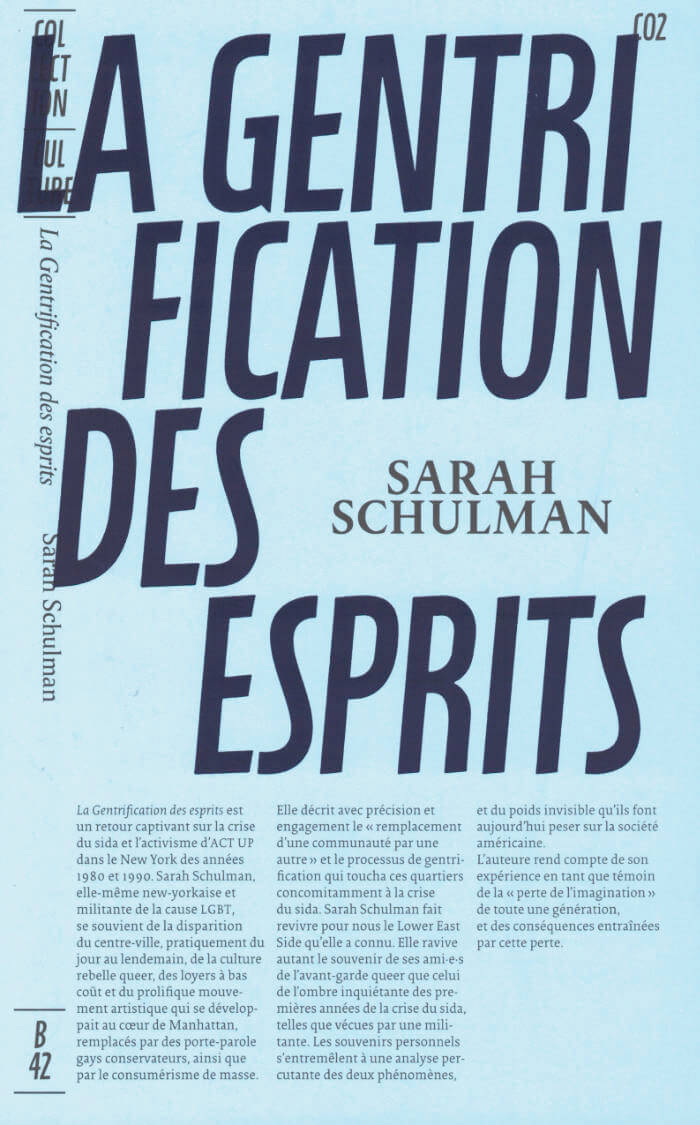
La Gentrification des Esprits
La Gentrification des esprits est un retour captivant sur la crise du sida et l’activisme d’ACT UP dans le New York des années 1980 et 1990. Sarah Schulman, elle-même new-yorkaise et militante de la cause LGBT, se souvient de la disparition du centre-ville, pratiquement du jour au lendemain, de la culture rebelle queer, des loyers à bas coût et du prolifique mouvement artistique qui se développait au coeur de Manhattan, remplacés par des porte-parole gays conservateurs, ainsi que par le consumérisme de masse.
Elle décrit avec précision et engagement le « remplacement d’une communauté par une autre » et le processus de gentrification qui toucha ces quartiers concomitamment à la crise du sida. Sarah Schulman fait revivre pour nous le Lower East Side qu’elle a connu. Elle ravive autant le souvenir de ses ami•e•s de l’avant-garde queer que celui de l’ombre inquiétante des premières années de la crise du sida, telles que vécues par une militante. Les souvenirs personnels s’entremêlent à une analyse percutante des deux phénomènes, et du poids invisible qu’ils font aujourd’hui peser sur la société américaine.
L’auteure rend compte de son expérience en tant que témoin de la « perte de l’imagination » de toute une génération, et des conséquences entraînées par cette perte.
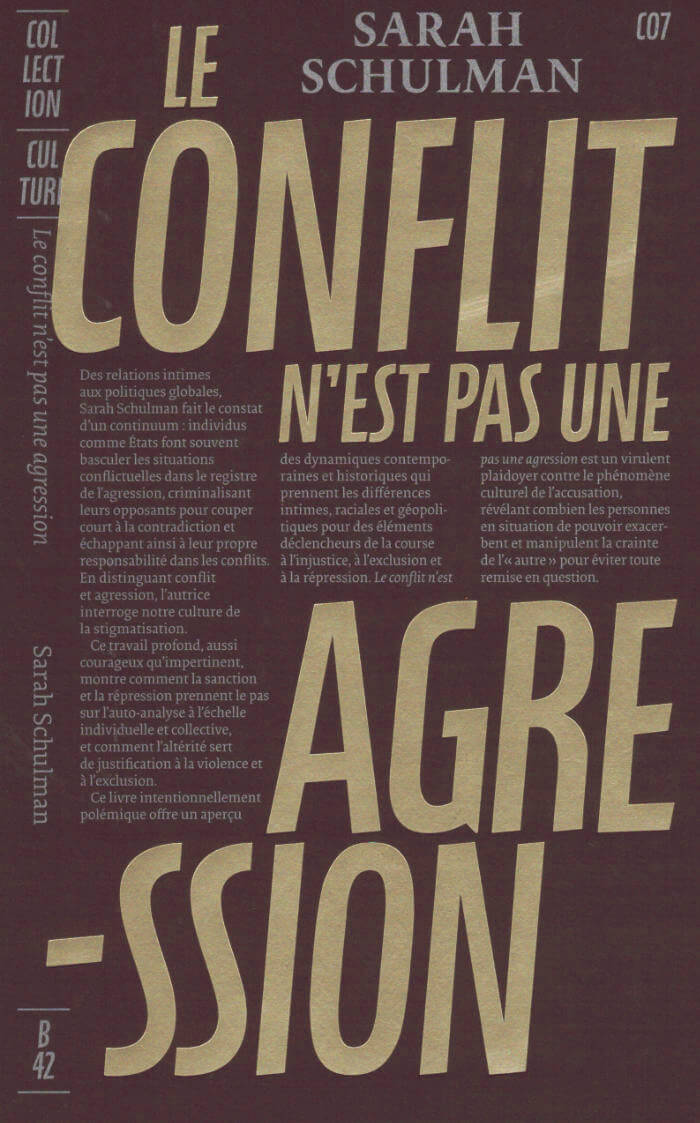
Le conflit n’est pas une agression
Des relations intimes aux politiques globales, Sarah Schulman fait le constat d’un continuum: individus comme États font souvent basculer les situations conflictuelles dans le registre de l’agression, criminalisant leurs opposants pour couper court à la contradiction et échappant ainsi à leur propre responsabilité dans les conflits. En distinguant conflit et agression, l’autrice interroge notre culture de la stigmatisation.
Ce travail profond, aussi courageux qu’impertinent, montre comment la sanction et la répression prennent le pas sur l’auto-analyse à l’échelle individuelle et collective, et comment l’altérité sert de justification à la violence et à l’exclusion. Ce livre intentionnellement polémique offre un aperçu des dynamiques contemporaines et historiques qui prennent les différences intimes, raciales et géopolitiques pour des éléments déclencheurs de la course à l’injustice, à l’exclusion et à la répression.
Le conflit n’est pas une agression est un virulent plaidoyer contre le phénomène culturel de l’accusation, révélant combien les personnes en situation de pouvoir exacerbent et manipulent la crainte de l’« autre » pour éviter toute remise en question.

Mon musée de la Cocaïne
L’or et la cocaïne sont les deux matériaux bruts de Mon musée de la Cocaïne. C’est au cours de leur transformation et raffinement que ces deux substances ramènent avec elles une histoire de l’oppression et de l’esclavage.
Dans ce livre, l’anthropologue australien Michael Taussig prend comme point de départ la proposition de bâtir un musée de la Cocaïne (qui serait l’image reflétée du musée de l’Or de la Banque de la République à Bogotá) et dresse un portrait sans concession de la vie des mineurs afro-colombiens aspirés dans le monde dangereux de la production de cocaïne au fin fond de la forêt tropicale, sur la côte pacifique de la Colombie. Il décrit la violence, la pauvreté, mais aussi les croyances qui surgissent des marais envahis de mangroves et des rivières tropicales qui, pendant plus de cinq cent ans, ont attiré, ruiné et décontenancé Amérindiens, orpailleurs, conquistadors et pirates, esclaves africains, ingénieurs russes et guérilleros marxistes.
Mon musée de la Cocaïne se présente comme un assemblage éclectique d’histoires et d’anecdotes, présenté comme autant de salles d’un hypothétique musée de la Cocaïne, au sein desquelles le lecteur est invité à déambuler, en croisant des références qui vont de Charles Dickens à Franz Kafka en passant par la poésie de Seamus Heaney.

Mélancolie Postcoloniale
Dans cet essai au verbe acéré, Paul Gilroy dénonce la pathologie néo-impérialiste des politiques mises en œuvre dans les pays occidentaux, sclérosés par les débats sur l’immigration, et propose en retour un modèle de société multiculturelle. De la création du concept de « race » à la formation des empires coloniaux, le sociologue britannique soulève quelques grandes questions de notre époque, et vise à faire émerger une réelle alternative aux récits édulcorés de notre passé colonial. En choisissant de mettre en avant la convivialité et le multiculturalisme indiscipliné du centre des grandes métropoles, Paul Gilroy défend une vision cosmopolite inclusive et plaide pour l’avènement d’une société qui refuse de céder aux discours de la peur et à la violence.
En examinant l’invention de catégories hiérarchisantes fondées sur la notion de race, et ses terribles conséquences, il démontre comment les écrits de penseurs tels que Frantz Fanon, W. E. B. Du Bois ou George Orwell peuvent encore faire avancer les réflexions sur le nationalisme, le postcolonialisme et les questions raciales. Mélancolie postcoloniale fait écho aux luttes postcoloniales d’aujourd’hui, en quête d’une pensée critique exigeante.

Palma Africana
Dans Palma africana, l’anthropologue australien Michael Taussig explore la production d’huile de palme en Colombie. Alors que cette dernière envahit tout, des chips au vernis à ongles, l’auteur examine les conséquences écologiques, politiques et sociales de cette exploitation.
Bien que la liste des horreurs induites par la culture du palmier à huile soit longue, nos terminologies habituelles ne permettent plus de rendre compte des réalités qu’elles décrivent. À travers cette déambulation anthropo-poétique au cœur des marécages colombiens, c’est donc la question du langage que l’auteur interroge. Comme William Burroughs, pour qui les mots sont aussi vivants que des animaux et n’aiment pas être maintenus en pages – Michael Taussig souhaite couper ces dernières, et les rendre à leur liberté.
Pensé à partir d’une vie d’exploration philosophique et ethnographique, Palma africana cherche à contrecarrer la banalité de la destruction du monde et offre une vision pénétrante de notre condition humaine. Illustré de photographies prises par l’auteur et écrit avec la verve expérimentale propre à l’anthropologue, ce livre est le Tristes Tropiques de Michael Taussig pour le XXIe siècle.
Traduit de l’anglais par Marc Saint-Upéry.
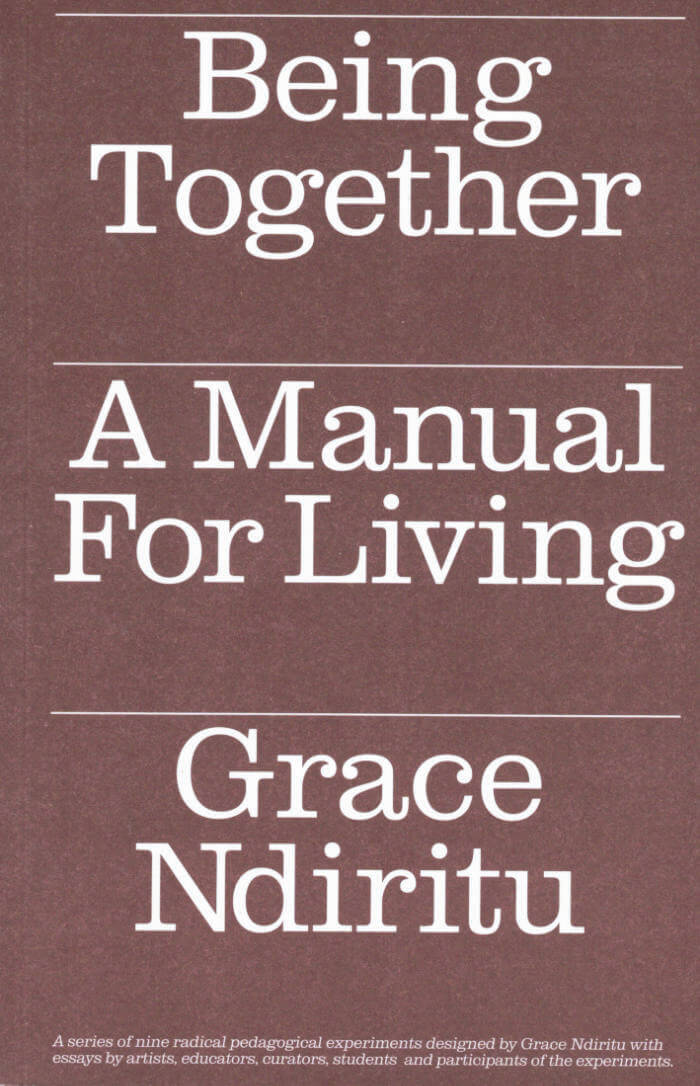
Being Together. A Manual for Living
Being Together: A Manual For Living falls in the lineage of publications such as The Journal of the Society for Education Through Art, which throughout the 1960s provided Britisch art schools a window into experimental education. By contrast, Grace Ndritu's experience in creating radical pedagogies arose from a connected, yet unorthodox system of 'self education'.
In 2012, she decided to spend time living in cities only when necessary. She thus lived in rural, alternative and often spiritual communities, while expanding her research into nomadic lifestyles, and training in esoteric studies, which she began following graduating art school. This research led her to visit Thai and Tibetan Buddhist monasteries, permaculture communities in New Zealand, forest tree dwellers in Argentina, neo-tribal festivals such as Burning Man in Nevada, a Scottish Hare Krishna ashram, and the Findhorn Spiritual Community in Scotland.
Such lifestyles forever transformed her ideas of education and have proven critical for her art, whether conducting social practices or working with students, peers and the general public; some of whose voices appear in this publication. Ndiritu posits, "What does (art) education mean today?" and specifically, "What does an embodied (art) education mean in a time of pandemics and social unrest?". Being Together: A Manual For Living attempts to answer these complex questions.
This book is published on the occasion of Grace Ndiritu's solo show at KRIEG? in Hasselt, Belgium.
Contributors: Philippe Van Cauteren, Pieter Vermeulen, Grace Ndiritu, Rafaela Lopez, Roberto dell’Orco, Jana Haeckel, Katleen Vermeir & Ronny Heiremans, Nathalie Boobis, Shayla Perreault, Edward Ball, Guadalupe Martinez, Stacy Suy, Ezra Fieremans.
Editors: Pieter Vermeulen, Grace Ndiritu
Copy editor: Sue Spaid
Design: Vrints-Kolsteren
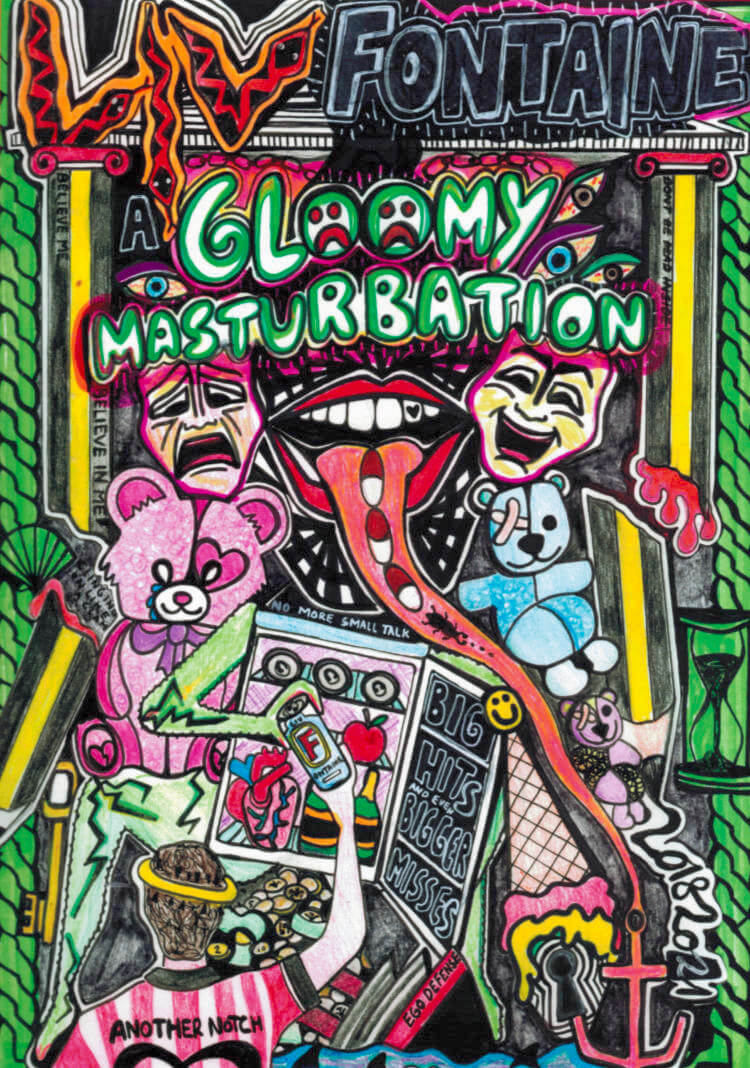
A Gloomy Masturbation
Featuring a selection of drawings from Fontaine’s ongoing project 'A Gloomy Masturbation' this book takes the reader on a trip through the artist's mind. The work functions as part diary, part fantasy, and part information, chronicling her own chronic sickness, fixating on her many failed romantic relationships, and exploring therapeutic theories of the mind and the precarious political situations of our time. Expect tragic comedy, slippery statements, radical honesty, and total teenage angst.

School Of Equals
Stijn Van Dorpe, Sarah Késenne
This book navigates the debate on (in)equality and arts education in a variety of ways. The process that editors Stijn van Dorpe and Sarah Késenne used to compile it follows a dialogue in which they provided contexts to one another but also strayed into the complexity of stories, viewpoints, and contradictions. They distinguish three different “politics”; three ways they believe the research has critical power and the potential to trigger action: through active, analytical, and corrective power; (in)consistencies; and (shared) praxis.
The book forms part of a series of projects and activities that they began as an initiative within the Audiovisual and Visual Arts Master at the LUCA School of Arts in Belgium.